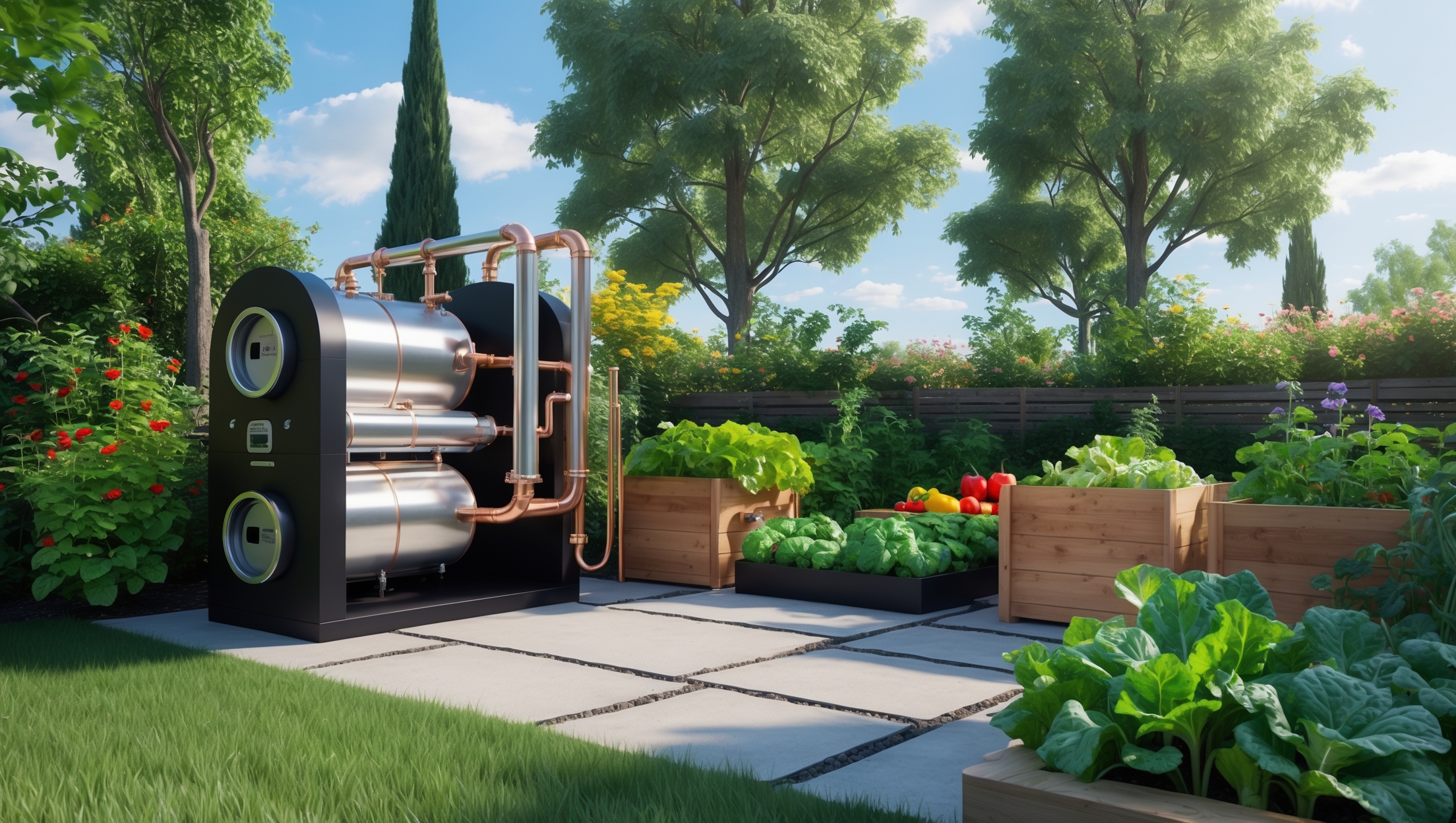Introduction: Why Invest in a Home Biogas System?
As the quest for sustainable living intensifies, more homeowners are looking for innovative ways to reduce their reliance on fossil fuels and make the most out of organic waste. Home biogas systems offer a practical, eco-friendly solution by converting household organic waste—such as food scraps and animal manure—into clean, renewable biogas for cooking and nutrient-rich slurry for gardening. Setting up your own home biogas system is not only a smart environmental choice but also a step toward energy independence and reduced utility costs. However, getting started requires careful planning and the right equipment. This comprehensive guide walks you through the essential tools and equipment needed for a successful home biogas installation, tailored for the hands-on homeowner who wants to turn waste into energy efficiently and safely.
Understanding Home Biogas Systems: Components and Function
Before diving into the tools and equipment, it’s essential to understand the basic components of a home biogas system. At its core, the system consists of an airtight digester tank, an inlet for organic material, an outlet for slurry, and piping to channel the produced biogas to your kitchen or appliances. The process relies on anaerobic bacteria breaking down organic matter, producing methane-rich gas as a byproduct.
- Digester Tank: The main chamber where anaerobic digestion occurs.
- Feedstock Inlet: A port for adding organic waste.
- Slurry Outlet: For removing digested material (bio-slurry).
- Gas Outlet and Piping: Channels biogas to storage or directly to appliances.
- Gas Storage Bag or Dome: Temporary storage for collected biogas.
Knowing these parts will help you select the right tools and equipment for each phase of setup.
Pre-Installation Planning: Site Assessment and Preparation Tools
Choosing the Right Location
A suitable site is crucial for optimal biogas production and system longevity. The site should be:
- Close to the kitchen or gas appliances (to minimize gas piping distance).
- Away from water sources to prevent contamination.
- In a spot with stable ground and some sun exposure (to help maintain optimal digester temperature).
Site Assessment Tools
- Measuring Tape: For accurate spacing of components and layout planning.
- Spirit Level or Laser Level: To ensure the digester sits evenly and safely.
- Shovel and Pickaxe: For soil testing and initial site clearing.
- Soil Thermometer: To check if the ground temperature is suitable (ideally above 15°C/59°F for optimal digestion).
Essential Tools for Home Biogas System Assembly
Excavation and Base Preparation
- Shovel, Spade, and Hoe: For digging the pit or leveling the ground.
- Wheelbarrow: To transport soil and materials.
- Compactor or Tamper: To create a stable, compacted base for the digester tank.
Tank Installation and Plumbing
- Pipe Cutter: For cutting PVC or HDPE pipes to required lengths.
- Pipe Wrench: For tightening and securing pipe fittings.
- Adjustable Spanner: Versatile tool for various fasteners.
- Drill with Bits: For making holes in tanks or walls for piping as needed.
- PVC Cement and Primer (or relevant adhesive): For leak-proof pipe connections.
- PTFE Thread Seal Tape: To ensure gas-tight threaded connections.
- Rubber Gasket Material: For creating custom seals where needed.
- Hacksaw: For metal pipe adjustments if required.
Gas Line Installation
- Flexible Gas Pipe or HDPE Tubing: For routing biogas safely.
- Pipe Clamps and Fasteners: To secure gas lines along walls or underground.
- Gas Valve and Regulator: For safety shut-off and pressure control.
- Leak Detector Spray or Soap Solution: For checking all connections for leaks before use.
- Gas Tightness Tester (optional): For professional-grade pressure testing.
Equipment: Choosing the Right Digester and Accessories
Types of Home Biogas Digesters
- Prefabricated Polyethylene Digesters: Easy to install, lightweight, and durable. Ideal for most homeowners.
- Concrete or Brick Digesters: More permanent but labor-intensive and require masonry skills.
- DIY Barrel Digesters: Cost-effective for small-scale setups but may require more frequent maintenance.
Choose a size based on your household’s organic waste volume and biogas needs. For a family of four, a 1–2 cubic meter digester is typically sufficient.
Gas Storage and Appliances
- Biogas Storage Bag or Dome: Collects and holds the gas until use. Some digesters have built-in domes; external bags are available for extra storage.
- Biogas Stove or Burner: Specially designed for low-pressure, variable-content biogas. Ordinary LPG burners are not ideal.
- Backflow Preventer Valve: Prevents air from entering the digester.
- Pressure Gauge (optional): Monitors gas production and pressure in the system.
Feedstock Handling
- Chopping Board and Knife or Food Waste Grinder: To reduce feedstock particle size for faster digestion.
- Buckets or Tubs: For collecting and transporting kitchen scraps or manure.
- Gloves and Aprons: For hygienic waste handling.
Installation Step-by-Step: Applying Your Tools and Equipment
1. Excavation and Base Setting
Mark the digester area using your measuring tape, and dig the required pit using shovel and pickaxe. If your system is above-ground, ensure the surface is flat and compacted using a compactor. Lay bricks or a concrete slab for stability if needed.
2. Placing the Digester and Connecting Inlets/Outlets
Set the digester tank in place, ensuring it is level. Use your spirit or laser level to double-check. Attach inlet and outlet pipes using the pipe cutter, PVC cement, and pipe wrench. Secure connections with PTFE tape and test for leaks with a soap solution.
3. Gas Line Setup
Run flexible gas tubing from the digester’s gas outlet to the storage bag or directly to your stove. Use pipe clamps and fasteners to secure piping, and install the gas valve and regulator before the appliance. Test all joints for leaks before first use.
4. Appliance Installation
Connect your biogas stove or burner using the proper fittings. Install a backflow preventer valve and pressure gauge if available. Run a final leak test before firing up the system.
5. Feedstock Preparation and Initial Feeding
Chop or grind food waste for faster digestion. Mix with water to a slurry and add to the digester using buckets and the feedstock inlet. Keep safety gear on during this process.
Safety and Maintenance Equipment
- Gas Leak Detector Spray or Soap Solution: For regular leak checks.
- Fire Extinguisher (Class B): Should be kept nearby in the kitchen and at the digester site.
- Protective Gloves and Eye Protection: To avoid contact with raw feedstock or slurry.
- Cleaning Brush and Hose: For periodic cleaning of the inlet and outlet pipes.
- Replacement Seals and Gaskets: For quick fixes in case of wear or leak.
Regular inspections using these tools are critical for safe, long-term operation.
Optional Tools and Smart Upgrades
- Temperature Data Logger: For monitoring digester temperature trends.
- pH Test Kit: To assess and adjust digester acidity for optimal bacterial activity.
- Automatic Feeding Pump: For larger home systems or if the digester is far from the kitchen.
- Rain Shelter or Insulation Materials: To protect outdoor digesters from extreme weather.
These additions can boost system efficiency and reduce manual intervention.
Cost Considerations: Budgeting for Tools and Equipment
Starter Tool Set (Estimated Costs)
- Basic Hand Tools (shovel, spade, wrench, saw): $50–$100
- Pipe Tools and Fittings: $40–$80
- Leak Detection Kit: $15–$30
- Protective Gear: $20–$40
Equipment (Estimated Costs)
- Prefabricated Polyethylene Digester (1–2 m³): $400–$900
- Gas Storage Bag/Dome: $60–$200
- Biogas Stove: $60–$120
- Flexible Gas Pipe and Fittings: $30–$60
Optional upgrades—such as temperature loggers, pH kits, or automatic pumps—can range from $30 to $200 each. Total initial investment for a basic home system is typically between $600 and $1,500, depending on market prices and system size.
Suppliers and Sourcing Tips
- Look for reputable, certified suppliers for digesters and gas appliances.
- Purchase plumbing and safety equipment from local hardware stores to minimize delays.
- Consider second-hand tools for excavation or base preparation to save costs.
- Check for local biogas support programs or subsidies—these may cover part of the initial investment.
Installation Tips for First-Time Builders
- Always double-check manufacturer instructions for the specific digester model.
- Consult local regulations regarding biogas systems; some areas require permits or inspections.
- Enlist a helper for heavy lifting and pipe installation to ensure safety and accuracy.
- Keep a logbook of installation steps and tool usage—it helps with future maintenance and troubleshooting.
Conclusion: Empowering Your Sustainable Lifestyle with the Right Tools
Installing a home biogas system is one of the most hands-on, rewarding steps you can take toward a more sustainable, resilient lifestyle. With the right set of tools and equipment—carefully chosen to suit your space, household needs, and local climate—you can transform kitchen scraps and other organic waste into clean, renewable cooking gas and nutrient-rich slurry for your garden. While the initial setup involves some investment and elbow grease, the long-term benefits are substantial: lower energy bills, reduced reliance on fossil fuels, responsible waste management, and a powerful sense of environmental stewardship.
Remember, the key to a successful biogas installation lies in thoughtful planning, precise tool selection, and methodical assembly. Don’t cut corners with safety gear or leak detection—these are non-negotiable for your household’s well-being. As technology advances, new accessories and smart tools continue to make biogas systems safer and more efficient. Stay curious, stay safe, and enjoy the process of turning yesterday’s waste into tomorrow’s sustainable energy. With this comprehensive equipment guide, you’re well-equipped to embark on your home biogas journey—one that brings both ecological and practical rewards for years to come.





For someone living in a suburban area in the US with cold winters, what insulation methods or materials would you recommend for the digester tank to keep the biogas production going year-round?
For cold suburban climates, insulating your digester tank is crucial to maintain steady biogas production. Consider using rigid foam panels, spray foam insulation, or wrapping the tank in fiberglass blankets. Adding a weatherproof outer layer, such as plastic sheeting, helps protect insulation from moisture. Some people also build a small insulated shed around the digester or use heating cables if temperatures drop very low.
For a family on a tight budget, what are the most essential pieces of equipment needed to get started with a basic home biogas system, and are there any DIY alternatives for the main components?
For a budget-friendly home biogas system, the essentials are an airtight digester tank (like a large plastic drum), inlet and outlet pipes, a gas storage bag or container, and simple piping to your stove. Many people use repurposed barrels or water tanks for the digester and DIY gas bags made from thick plastic sheeting. With careful assembly and safety checks, these DIY alternatives can save money while still being effective.
Do you have any advice for keeping the cost down when sourcing materials for the gas storage bag or dome? I want to make this as budget-friendly as possible without sacrificing quality or safety.
To keep costs down without sacrificing quality, consider repurposing sturdy PVC or rubberized tarpaulins for the gas storage bag. These can often be found as offcuts or secondhand. For domes, recycled plastic barrels or tanks are a smart choice if they’re in good condition. Always prioritize materials that are gas-tight and UV-resistant, and thoroughly check for leaks after assembly to ensure safety.
I’m wondering about the best way to run piping from the gas outlet to my kitchen appliances. Are there safety considerations or common pitfalls I should be aware of during this phase of installation?
When running piping from your biogas outlet to kitchen appliances, it’s important to use gas-rated, pressure-resistant materials such as HDPE or copper pipes. Ensure all fittings are tightly sealed to prevent leaks. Keep the piping route as short and direct as possible, avoiding sharp bends. Install a gas shutoff valve near the appliances for safety. Always check for leaks using soapy water before using the system, and avoid running pipes near electrical lines or heat sources.